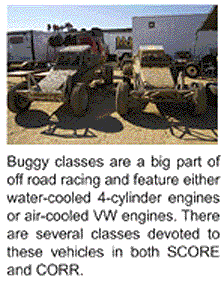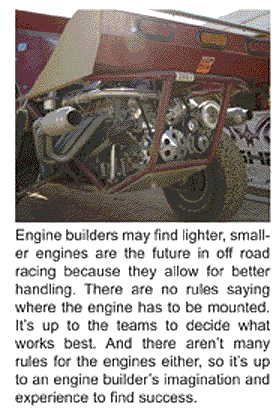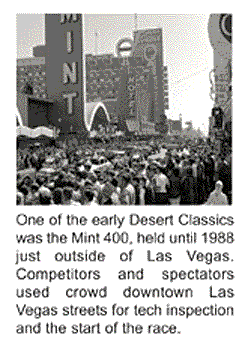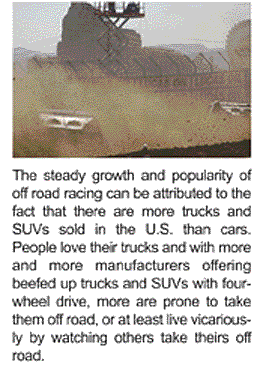It had been a long week in Las Vegas, manning the booth and getting the scoop on the performance market at the SEMA Show. I was tired and ready to catch a plane back home, but I had one last assignment before I left: Go into the desert and cover an off-road race.
 I woke up late that morning, with my head throbbing from the night before. I was reminded of another famous run out to the desert. It was back in 1971 when Hunter S. Thompson was assigned to cover the Mint 400 for Sports Illustrated. Although he never finished his assignment, his adventures were captured in a book and later turned into a movie: "Fear and Loathing in Las Vegas."
I woke up late that morning, with my head throbbing from the night before. I was reminded of another famous run out to the desert. It was back in 1971 when Hunter S. Thompson was assigned to cover the Mint 400 for Sports Illustrated. Although he never finished his assignment, his adventures were captured in a book and later turned into a movie: "Fear and Loathing in Las Vegas."
The Mint 400 used to be one of the most prestigious off-road events in the country, and it was held just outside of Las Vegas. The organizers would close Fremont Street and turn it into a large garage for tech inspections. That race is gone now, but off-road racing has, in one way or another, thrived in the Las Vegas desert since those days.
Admittedly, there have been downs as well as ups for some of the bigger off-road events over the years. The Mickey Thompson Stadium Series was popular for a time, but many feel it was simply ahead of its time. This year, the Baja 1000 is celebrating its 40th anniversary, and the car counts for the event have been rising steadily the last few years. In fact, there have been record car counts for many of the off road events this year.
Thompson may not have found what he was supposed to in Las Vegas, but if you are looking for a niche market on the rise, off-road racing may give you the ride you are looking for.
 One industry expert believes that a reason for the steady growth and popularity of off road racing is simple: there are now more trucks and SUVs sold in the U.S. than cars. People love their trucks and with more and more manufacturers offering beefed up trucks and SUVs with four-wheel drive, more are prone to take them off road, or at least live vicariously by watching others take theirs off road. Off road racing is one of the most torturous forms of motorsports around. It pushes vehicles, drivers, crews and equipment to the absolute edge. Engines are never at full throttle for long, and the shock loading from going into the air and back again so many times puts a severe strain on the vehicles, not to mention its occupants.
One industry expert believes that a reason for the steady growth and popularity of off road racing is simple: there are now more trucks and SUVs sold in the U.S. than cars. People love their trucks and with more and more manufacturers offering beefed up trucks and SUVs with four-wheel drive, more are prone to take them off road, or at least live vicariously by watching others take theirs off road. Off road racing is one of the most torturous forms of motorsports around. It pushes vehicles, drivers, crews and equipment to the absolute edge. Engines are never at full throttle for long, and the shock loading from going into the air and back again so many times puts a severe strain on the vehicles, not to mention its occupants.
The SCORE International Off Road Racing Series includes the desert racing classics such as the Baja 1000 and Baja 500. SCORE’s top tier class is the Trophy Truck class, which looks like a truck with a fiberglass body. The only rules in Trophy Truck are primarily for safety. Everything else – from the engine to the suspension – is unrestricted.
"There are many big cubic-inch, fully sequential electronic fuel-injected small blocks running in the Trophy Truck class," says Kevin Kroyer, Kroyer Racing, Las Vegas, NV, who builds engines for some of the top teams in Trophy Truck and Super Buggy. "There’s no size limitation; you can run whatever size engine you want. Most of the trucks are front engine, but there are a few mid-engine trucks as well." They look like pickup trucks, but that’s where the similarities end, says Kroyer. "In NASCAR Craftsman Truck Series racing (for which Kroyer has also built engines), there’s at least some sheet metal that is the same as the production truck. This is not the case in Trophy Trucks, which aren’t held to any templates. These are tubular-framed race vehicles that cost about $500,000 even before you put a powertrain in them."
 Most of the differences in building engines for off road SCORE or desert endurance racing purposes, say experts, concern the endurance factor. The annual Baja 1000 is actually 1,300 miles of punishing off-road racing. The winner will take 25 or 26 hours to complete the race, so the engines have to last for that long. They are pushing 6,500 lbs., in the case of a Trophy Truck, over all conditions and unlimited terrain for that entire span of time and distance.
Most of the differences in building engines for off road SCORE or desert endurance racing purposes, say experts, concern the endurance factor. The annual Baja 1000 is actually 1,300 miles of punishing off-road racing. The winner will take 25 or 26 hours to complete the race, so the engines have to last for that long. They are pushing 6,500 lbs., in the case of a Trophy Truck, over all conditions and unlimited terrain for that entire span of time and distance.
"The trucks will average somewhere around 55 mph for the race," says Kroyer. "In some of the dry lakebeds, the trucks can get up to 140 mph, but then there are sand washes and rock gardens where they might not even do 20 mph. We build engines to have a very broad torque band because you’re pushing such a heavy vehicle."
Kroyer and others say the off road market has been growing steadily over the last couple of years. "We’ve been doing off road engines for a long time," says Kroyer, "but the market has picked up for us, especially in the SCORE Series and Trophy Truck classes, as well as the Buggy classes. The endurance races seem to be growing and our customer base has picked up quite a bit. SCORE has had record entries in Trophy Truck and Class 1, which is Unlimited Buggy class. They have had record entries for just about every race this year."
"We build mostly SCORE endurance, SCORE Trophy Trucks, Class 1, Class 10, CORR Pro 2, CORR Super Buggy, so we cover both short course and endurance professional racing," says Kroyer. "It’s all high-end off road racing. We don’t do any sandbuggies or street/strip style engines."
Off road racing vehicles compete in mostly higher-end types of divisions because the vehicles are expensive, but there are few grassroots/regional events. The Championship Off Road Racing (CORR) Series started out as mostly a Midwestern series but was recently bought and the series has featured several races on the West Coast.
CORR racing brings high action four wheel motorsports including two-wheel drive and four-wheel drive trucks onto closed course off road tracks. The 2007 CORR season includes seven events in Los Angeles and San Diego, CA; Dallas, TX and NV.
CORR is divided into two series, Pro and Sportsman. The Pro Series is composed of three divisions: Pro 4 – Full-size 4wd race trucks, V8 engines, 800 hp; Pro 2 – Full-size 2wd race trucks, V8 engines, 800 hp; and Pro Lite – Compact/Mid-size 2wd race trucks, 4 cylinder engines, 300+ hp. The Sportsman Series is made up of two buggy divisions: Single Buggy – Limited to a 1600cc VW Type 1 engine; and Super Buggy – Featuring a 1650cc water cooled power plant.
Rick Caven, Speed-O-Motive, West Covina, CA, designs and builds the engines for the Pro 4 Baldwin Racing Team in the CORR Off Road Series. Involved with CORR racing for a couple of years now, Caven says the new owner of CORR has helped the series grow significantly. And next year, rumor has it, that many of the big manufacturers are looking at the series.
"Some of the old timers who run this series now and who have developed a lot of the technology in the truck series came from the Mickey Thompson Stadium Series days," Caven explains. "You may not know it to look at them but there are a lot of really sharp people in off road racing, just as in any form of motorsports."
 Caven says "I grew up road racing and still love that form of racing, but this is very exciting as well. Spectators can see all the way around the track, and you really can get close access the racers and teams. It’s not the same thing as desert racing because guys are really racing against each other here. Desert racing is more wide open."
Caven says "I grew up road racing and still love that form of racing, but this is very exciting as well. Spectators can see all the way around the track, and you really can get close access the racers and teams. It’s not the same thing as desert racing because guys are really racing against each other here. Desert racing is more wide open."
Speed-O-Motive did some development work for the Baldwin Team early on, after which the team stepped up and had Caven design a completely new engine. "Our engine is a 390 cubic-inch small block. It’s solely designed for this form of racing, although we used influences for the design from other forms of racing. We picked some of the best characteristics of engines to put into this one, but, basically, we started with a completely clean sheet of paper. We designed and built our own billet blocks, and it seems to be working really well so far."
"These engines are well suited to run both CORR and SCORE series, although there are some differences in the engines," says Caven. "A desert motor has a little less compression because we try to make them live longer. The desert motors make a little less power, but it’s a trade off between power and longevity. It’s not very often that a desert motor will see 7,000 to 8,000 rpm, but in the CORR series you see 9,700 rpm and some of the bigger cubic inch motors are turning just under 8,000 rpm."
At the moment, Caven says Speed-O-Motive has a very limited run of these engines, and is only supplying one team with them, but will begin production for more engines very soon. "We plan to build at least 5 to 8 more over the winter and offer them to other teams that are interested," according to Caven. He and other off road experts say some of the bigger cubic inch engines can actually make too much torque for the off-road racing. "Unless you get a driver who can really control his right foot, those bigger engines will just spin the tires, not putting the power down to the ground," says Caven. "This is especially the case in PRO 2 with its two-wheel drive trucks."
Those difficulties with the big cubic inch engines are why Caven started building the small block fuel-injected engine in the first place. It allows him to control the mapping completely. "We bring the torque in a lot with the smaller engine with about 600 lb.ft of torque. We bring it in slow and it lasts a long time. One of our drivers has told us that the engine never stops pulling. With too much torque it just rattles the tires and you just sit there."
There are still quite a few carbureted trucks competing in CORR and other off road events, according to Caven. The only fuel injected trucks in CORR this year are in Pro 4 and the Nissans and Toyotas in Pro 2. Caven points out that once you "half-master" EFI you have a lot more control with it. However, saying Caven just "half-mastered" EFI is the understatement of the century. He has been working with EFI for many years, beginning with Sprint Cars.
"There are two kinds of horsepower: the kind you buy and the kind you make from optimizing what you already have," Caven explains. "That is another reason I choose to work with fuel injection." He acknowledges that the bar keeps moving up every year and challenges engine builders to step up to the new technology and learn how to make the most of it. Otherwise, he says, you are not going to have much success.
Experts say that includes stepping up your game in the machining process and metal treating processes as well as component selection. You can’t just buy an aftermarket block off the shelf and expect to win anymore. There are a number of processes you have to do to the blocks for the engines to be competitive and to last. But there is a whole slew of things you need to do from the machining and honing and plating cylinders, which Caven says they are working with right now.
Croygenic processing has been around for number of years in NASCAR but it is starting to be used in off road racing as well as many other forms of racing, too.
Caven says he uses a ring pack that is less than 3 mm for the CORR engine, and that the oil ring is really just there for insurance. "We use less than a three pound oil ring; it’s just along for the ride. We control the oil mainly with the second ring. If we could get away with it we’d run one ring in the engine."
Since they have been in development this year and getting the engines back every race weekend, Caven says they are finding out that the engines can go two to three weekends without any major work. The only thing they’ve had to do so far is throw new bearings in.
Caven feels fortunate that Fel-Pro makes an MLS gasket and says he hasn’t had any issues sealing the engines. "The engine is Ford bore-spaced, so the liners are as big as we can get them without encroaching into the next liner."
The only areas where he sees problems with dirt are around the velocity stacks and the airbox. And because they are pulling so much vacuum in the engine they have to run special seals. "I lost an engine a couple of years ago in the desert because one of our seals failed, which was a standard heavy-duty seal, but it sucked in a lot of dirt. It didn’t blow up but it didn’t look good either. So now we use a special seal. If we didn’t run as much vacuum we could probably run the stock seals," says Caven.
"I don’t think any one team or builder has all the answers in this series," says Caven. "The rules say you can run one carburetor, one throttle body EFI, or you can run multiple stack-style fuel injection, which is what we run. From my Sprint Car days, I’ve come to understand it a little better. The engines have a different characteristic with this setup. I think it’s a very good setup for this class. We can treat each cylinder as an individual engine with the multiple stack system, which is something you can’t do with a carb or throttle body EFI. We can break things up a bit more and run a different fuel and timing map per gear. Right now there are only two gears, but with the smaller engines there are multiple gears."
Engine builders may find lighter, smaller engines are the future because they allow for better handling, say experts. Most of the engines are mounted in the front, but there are no rules saying where the engine has to be mounted. It’s up to the teams to decide what works best. And there aren’t many rules for the engines, which has got to be music to an engine builder’s ears.
Hunter S. Thompson found off-road racing too much to handle. For you? It may be a different story.
For more information about CORR off road racing visit www.corracing.com.













